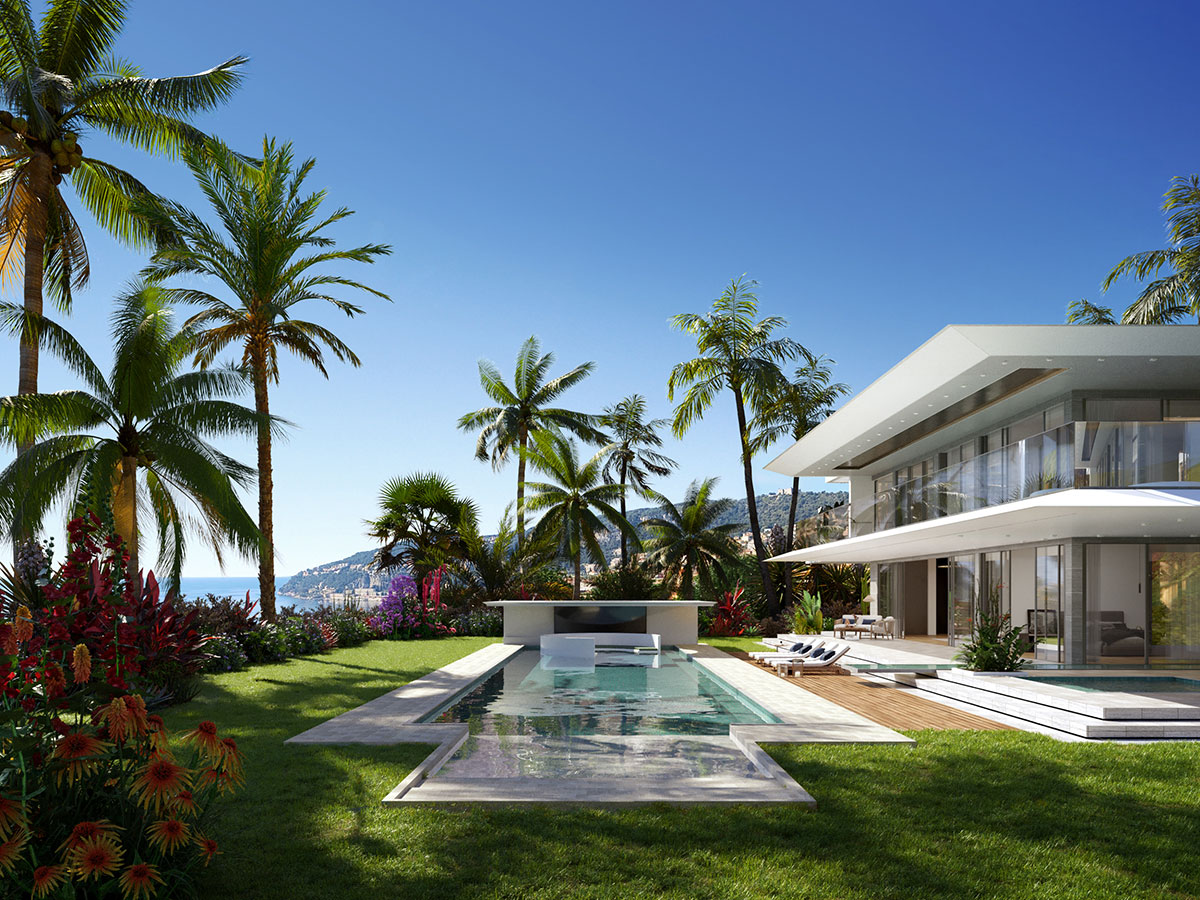Top Landscape Renderings Tools: Elevate Your Design Process

Arqsix
February 10th, 2024

When it comes to landscape design, seeing is believing. That’s where landscape renderings step in. This guide shaves through the complexity and serves up the top tools you need to transform your designs from ideas to engaging visuals — all without overwhelming detail.
The Importance of Landscape Renderings in Architectural Projects
 Created by Arqsix
Created by Arqsix
Landscape renderings, far from being just pretty pictures, have brought a revolutionary change in the architectural world, becoming an integral part of architectural projects. Visualizing the overall design concept, landscape renderings help clients envision the end product, ensuring expectations are aligned, and aiding in decision making. They serve as clear visual references, fostering efficient collaboration and conserving both time and resources throughout the construction phase. With the ability to render landscape architecture, these visualizations have become indispensable tools in the industry.
Furthermore, advancements in digital technology have simplified the creation of 2D or 3D images of landscape design concepts. This has led to a surge in the use of landscape architectural renderings and sparked a new conversation about their importance in the field of landscape architecture. The rise of real-time rendering and the ability to create photorealistic renderings have made them an indispensable part of the design process.
Visualizing the Design Concept
Imagine trying to describe a complex landscape design to a client. It can be a daunting task. However, 3D landscape renderings empower designers to depict these intricate landscape designs through captivating 3D illustrations, thereby bringing the vision and complexities of a project to life. They can highlight the value of green spaces in an overall design using computer-generated imagery (CGI).
In addition, these renderings have the capability to display landscapes and plant life throughout various seasons, illustrating the transformation of design features over time. By accurately showing plant life and seasonal changes in renderings, designers can convey the ecological approach and the sustainability aspects of their design concepts. Landscape renderings as a design tool facilitate inclusive communication, allowing all parties involved in the design process to quickly understand and visualize the proposed design.
Facilitating Client Communication
In a world where clients are becoming increasingly involved in the design process, landscape renderings play a crucial role in communication. These renderings give clients a realistic depiction of the final design, fostering informed decision-making and enabling the incorporation of feedback and alterations to match the client’s vision.
Additionally, 3D landscape renderings offer the following benefits:
● Streamline the conveyance of intricate landscape design concepts
● Aid clients in comprehending the full scope and depth of the project
● Enable clients to vividly see the proposed materials in context
● Enhance their ability to visualize how different elements will come together in the actual space
● Reduce time spent interpreting blueprints
● Streamline the design approval process
Streamlining the Construction Process
Transitioning from design to construction can prove to be a complex process. In these instances, precise 3D landscape renderings are invaluable. By permitting preliminary design adjustments, they prevent expensive alterations during construction, leading to a more efficient utilization of time and resources.
3D renderings provide designers with the opportunity to:
● Make informed design changes before breaking ground, streamlining the communication and expectations with clients
● Create a complete and detailed land structure blueprint for the construction phase, simplifying site and plan analysis
● Expedite client approvals
These renderings are a valuable tool in the design process, helping to ensure that the final product meets the client’s vision and expectations.
Ultimately, they speed up the construction process, ensuring the timely delivery of projects.
Top Tools for Creating Landscape Architecture Renderings
 Generated by SurferAI
Generated by SurferAI
In the realm of landscape architecture rendering, several tools have proven their worth. Rhino and Enscape are recommended for 3D-modeling and rendering, respectively, to create realistic landscape architecture visualizations. The advent of cloud-based 3D rendering software has made it even easier for designers to quickly generate designs and incorporate real-time feedback and collaboration with clients.
Among tools utilizing real-time raytracing technology, D5 Render is a standout performer. It presents landscape projects in a realistic and immersive way, providing quick rendering output. But, let’s not forget about SketchUp and V-Ray, both of which offer their unique capabilities and features, setting new standards in the field of landscape architecture renderings.
However, if you want to learn more about these tools, you should check out 3D Agora’s guide to them.
Lumion
When it comes to rapid rendering capabilities and a user-friendly interface, Lumion stands out. It’s a tool that has won the hearts of architects and landscape designers. With Lumion, professionals can import base 3D models from different design software and enhance them with an extensive library of lifelike trees, plants, and decorative elements.
Furthermore, Lumion excels at delivering the requisite level of detail in renderings. Whether it’s a small outdoor space or a sprawling landscape, Lumion has the ability to make it come to life in a detailed landscape architecture visualization.
SketchUp
SketchUp is another tool that has carved its niche in the landscape architecture rendering world. It’s highly recommended for landscape architects due to its:
● Ease of use
● Extensive catalogue of ready-made components for landscape design
● Compatibility with most rendering tools, allowing designers to enhance their visualization capabilities seamlessly.
The software also offers unique features such as the Shadow Analysis plug-in, which can be used to model a property’s solar profile, showing how different materials will interact with sunlight and cast reflections. This level of detail contributes to the photorealistic renderings that make SketchUp a go-to tool for many landscape architects.
V-Ray
When it comes to high-quality visuals, V-Ray is a leading solution. It’s a rendering engine that’s globally recognized for delivering unparalleled presentation quality, especially in the context of landscape architecture.
However, the high performance of V-Ray is accompanied by a steep learning curve and a premium price tag. This aligns it with professional users who demand top-tier quality. Nonetheless, for those who strive for perfection in their landscape architectural renderings, V-Ray is undoubtedly a worthy investment.
Enhancing Landscape Renderings with Realistic Lighting Effects
 Created by Arqsix
Created by Arqsix
The journey from a 3D model to a photorealistic rendering is not just about adding colors and textures; it’s also about mastering lighting. Realistic lighting effects are crucial in landscape renderings as they contribute significantly to the visual authenticity of the design, especially when replicating real world terrain.
Tools like V-Ray excel in producing high-quality visuals and animations, enabling landscape architects to achieve realistic lighting in their renderings. The right balance of shadows, highlights, and reflections can make the difference between a flat, lifeless image and a vibrant, realistic rendering that seems to spring to life.
Sun Position and Shadows
In the world of landscape rendering, the sun plays a starring role. The accurate representation of the sun’s position is crucial for creating realistic shadows and highlights, enhancing the visual quality of the design. Achieving this requires:
Capturing images at different times of the day in sunny conditions
Using photo-editing software to generate a composite image
Mapping sunlight exposure and shading patterns in landscape renderings
Moreover, sun angles are affected by seasonal and geographical variations. Therefore, creating sun maps for different times of the year is essential to ensure accurate shadow representation in renderings. Consistency in shadow placement is also crucial; shadows should be uniformly placed on the same side of objects, with special consideration for plant and hardscape shadows to maintain depth and readability.
Reflections and Material Properties
Lighting isn’t just about the sun and shadows; it’s also about reflections. The properties of different materials can greatly affect how they reflect light, adding another layer of realism to landscape renderings.
From the gleaming surface of a pool to the lustrous leaves of a tree, reflections infuse a scene with a depth of realism that is truly captivating. The level of realism achievable through careful attention to reflections and material properties can take a landscape rendering, including outdoor furniture, from being merely good to truly remarkable.
The Art of Hand-Drawn Landscape Renderings
 Created by Arqsix
Created by Arqsix
In an era dominated by digital technology, one might wonder if there’s still a place for hand-drawn renderings. Surprisingly, the answer is a resounding yes. Hand-drawn renderings remain a significant medium for landscape architects to express their initial design concepts quickly and fluidly.
Despite the advantages of digital tools, hand-drawing provides a level of freedom and creativity that’s unmatched. It allows for rapid production of multiple concept versions and fosters the development of the designer’s creative skills. However, hand-drawing also has its downsides, such as paper being prone to damage and the limitation of having only one original work.
Combining Digital and Hand-Drawn Techniques
Why limit oneself to either digital or hand-drawn methods when a combination of both provides the best results? Many landscape architects adopt a hybrid approach, utilizing the efficiency and versatility of computer-aided design while retaining the personal touch and creative freedom of hand drawing.
This blend of techniques not only provides a uniqueness to the drawings but also offers the editing and sharing capabilities of digital tools, alongside the benefit of hand sketching to instantly capture the mind’s ideas.
The result? A dynamic and evolving creative workflow that produces visually stunning and conceptually strong landscape designs.
The Role of Sketching in Landscape Design
Sketching plays an indispensable role in landscape design. It allows landscape architects to:
● Quickly represent multiple solutions and conceptual ideas
● Use a more organic and expressive method to capture basic ideas
● Create initial designs more successfully than computer drafting in the early stages of design.
Additionally, the practice of redrawing during the sketching process enhances the design quality by encouraging a closer scrutiny of the proposed solutions. This iterative process, where ideas are sketched, refined, and then sketched again, makes sketching an invaluable tool in the landscape designer’s toolbox.
Case Study: Arqsix Landscape Projects
 Created by Arqsix
Created by Arqsix
Arqsix, a leading architectural visualization company, boasts a portfolio filled with successful landscape projects, exemplifying the power and potential of landscape rendering. With the expertise of a landscape architect, take the Eastside Kvartalet project, for example. It is an example of landscape transformation in Stavanger, showcasing their skill in crafting detailed environment visuals.
Arqsix has also demonstrated expertise in nautical-themed environments through their Durrës Yachts & Marina project, highlighting luxurious marine and yachting facilities. And then there’s the project in Aegina, Greece, which reflects Arqsix’s versatility in adapting their landscape rendering techniques to various geographical and design contexts. These projects not only highlight the capabilities of Arqsix but also the potential of landscape rendering as a whole.
Summary
Landscape architecture rendering is a fascinating blend of art and technology. It brings architectural concepts to life, facilitates communication with clients, and streamlines the construction process. From tools like Lumion, SketchUp, and V-Ray to the art of hand-drawn renderings, the journey of creating a landscape rendering is as engaging as the final product itself. As landscape architects continue to explore and innovate, the field of landscape rendering is set to evolve, offering even more possibilities for visualizing our built environment.
FAQs
Our location
Ready to share your expertise?
We welcome submissions from talented writers and experts in various fields who are passionate about sharing their knowledge and insights with our audience.
Write for UsArqsix - Shaping Stories, Shaping Spaces
Elevating real estate marketing for a world that’s always evolving.
2025 © Arqsix. All Rights reserved. |Sitemap|Privacy Notice